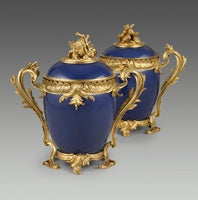| |
 |
|
|
| |
Pair of Deep Blue Chinese Porcelain Jars with French Gilt-Bronze Mounts
Porcelain, China, 1st half of the eighteenth century
Gilt-bronze mounts, France, 1745-49
1915.8.41: 17 7 ⁄8 x 18 5 ⁄8 x 10 11 ⁄16 in (45.4 x 47.3 x 27.1 cm);
1915.8.42: 18 7 ⁄16 x 18 5 ⁄8 x 10 5 ⁄8 in. (47 x 47.3 x 27 cm).
The Frick Collection, New York
(photo: Michael Bodycomb) |
|
|
In 1915 Henry Clay Frick acquired the magnificent pair of mounted porcelains that are the focus of this exhibition. Assembled in Paris shortly before 1750, the Frick jars combine imported Chinese porcelain and French gilt-bronze mounts modeled to imitate bulrushes curling along the handles and shells, sea fans, corals, and pearls on the lids. Originally, the Frick porcelains were probably tall jars. On their arrival in France, however, they were sawed apart, once at the neck and once at the shoulder, to form lidded vessels that could be fitted with gilt-bronze bases, handles, and finials. Frick’s mounted porcelains fuse eighteenth-century French collectors’ appreciation of rare Asian porcelain with their enthusiasm for natural curiosities. They illustrate the fascination with the exotic and the play between nature and art that animates Rococo design.
Artists such as François Boucher, Pierre-Quentin Chedel, Pierre-Edmé Babel, and the unknown designer of the Frick mounts freely interpreted marine motifs and transformed them into the daring, irregular forms called rocaille that are the hallmark of the Rococo. A sophisticated decorative style that emerged in Paris in the 1720s and remained in vogue until the 1750s, the Rococo was based on the imaginative interpretation of natural forms, especially shells, the most spectacular of which, like porcelains, came from the East. Willfully disregarding scale and symmetry, artists played with the contrast between materials and the dynamic, sensuous forms they created. Like the gilt-bronze imitations of sea life and freshwater bulrushes on the Frick jars, the Rococo dazzled the senses by artfully blurring the boundaries between the beautiful creations of nature and the inspired invention of the artisan.
Rococo Exotic: French Mounted Porcelains and the Allure of the East is accompanied by a fully illustrated publication that features an introduction by Chief Curator Colin B. Bailey as well as an essay by Andrew W. Mellon Fellow Kristel Smentek, catalogue entries, and a bibliography. It is available in the Museum Shop of The Frick Collection. |


